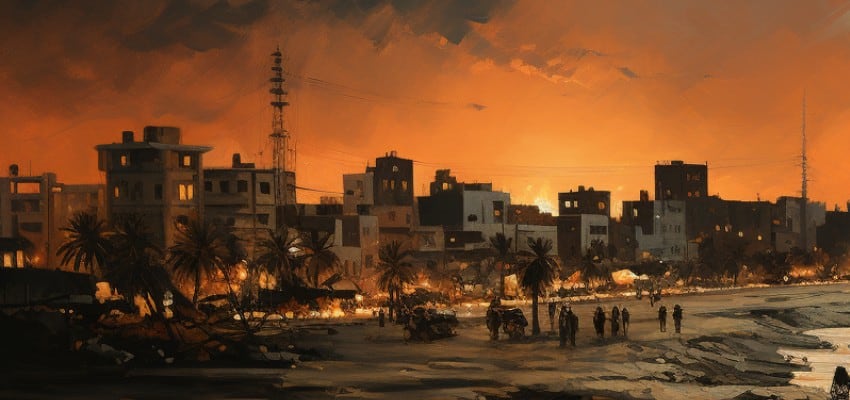|
|
ARCHIVED CONTENT
You are viewing ARCHIVED CONTENT released online between 1 April 2010 and 24 August 2018 or content that has been selectively archived and is no longer active. Content in this archive is NOT UPDATED, and links may not function.Content Assessment: Flashpoints and Frontlines: A Week of Middle Eastern Military Escalations in the Israel-Hamas War (October 25 - November 2, 2023)
Information
Insight
Relevance
Objectivity
Authority
Excellent
A short assessment of the qualitative benefit of the recent update on Iran and Iranian-sponsored activities manifesting in an Israel-Hamas War prepared by ComplexDiscovery from reporting and maps sourced from Institute of the Study of War.
Editor’s Note: The Institute for the Study of War provides invaluable insights into Iranian activities and dynamics through its regular Iran Update briefings. Published in coordination with the Critical Threats Project at the American Enterprise Institute, these updates offer in-depth analysis of Iranian-sponsored activities across the Middle East and beyond. Recently CTP and ISW have refocused updates to cover the Israel-Hamas war. The new sections address developments in the Gaza Strip, the West Bank, Lebanon, and Syria, as well as noteworthy activity from Iran’s Axis of Resistance.
For ongoing coverage of Iranian activities across the Middle East and the current Israel-Hamas War, the Institute for the Study of War also provides maps charting influence, activities, and outbreaks across the region. These maps present vital information about Iranian proxies and allies. They also show how Tehran projects power to pursue its strategic goals. The Iran Updates and supporting maps offer vital resources to track Iran’s destabilizing actions and manifestations, such as the Israel-Hamas War.
Today’s Iranian Update coverage by ComplexDiscovery OÜ spans October 25 – November 2, 2023, with coverage spurred by the unprecedented attack by the Palestinian militant group Hamas on Israel on October 7, 2023. This dangerous regional escalation with international implications will continue to be covered by ComplexDiscovery OÜ in addition to its regular reporting on the Russo-Ukrainian War.
Source Note: One of the most accurate and detailed sources for ongoing updates on the Middle East crisis is the Iran Update from the Institute for the Study of War. The Institute for the Study of War (ISW) is a 501(c)(3) organization and produces strictly non-partisan, non-ideological, fact-based research. ISW seeks to promote an informed understanding of war and military affairs through comprehensive, independent, and accessible open-source research and analysis. ISW’s research is made available to the general public, military practitioners, policymakers, and media members. Providing a regular synthesis of key events related to Iranian activities in the region, ISW updates may benefit investigators and litigators as they follow the business, information technology, and legal trends and trajectories impacted by and stemming from Iran’s destabilizing actions across the Middle East and the current hostilities in the Isreal-Hamas War.
For those seeking to grasp the full scope of this evolving landscape, the complete updates from the Institute for the Study of War serve as an invaluable resource.
Assessments and Maps*
Middle Eastern Conflict Assessments
- Institute for the Study of War (ISW)
- Critical Threats Project (CTP), American Enterprise Institute
General Assessment Background Info
- ISW systematically publishes Iran Updates, including maps highlighting key events and activities.
- Maps augment regular synthetic products that cover key events related to potential Iran-sponsored activities across the Middle East.
Iran Update Summary (October 25 – November 2, 2023)
This report summarizes key events and developments in the ongoing Israel-Hamas war from October 25 – November 2, 2023, based on daily updates from the Institute for the Study of War.
Over the past week, long-simmering tensions in the Middle East have erupted into intensive fighting as Israel remains embroiled in an escalating multi-front conflict with Palestinian militant factions, including Hamas in Gaza. What began as localized clashes has now expanded into a complex regional crisis drawing in Iran and its proxies across multiple borders. Despite international appeals, the two sides remain locked in fierce hostilities with no end in sight.
Coordination and Escalation
Iran’s Axis of Resistance and its affiliates enacted a strategy aimed at deterring Israel from launching a ground invasion of Gaza and discouraging U.S. military support for Israel on October 25. Hamas heightened its offensive, launching rockets toward major Israeli cities and waging an information war to undermine Israeli public and political support for a ground operation. In the West Bank, the Iran-linked Lions’ Den militia called for unrest, successfully drawing IDF resources to the area. Concurrently, hostilities along the Israel-Lebanon border escalated, with the Axis targeting IDF units to draw forces northward and set the stage for possible future incursions. The day also saw sustained Palestinian militia attacks from Gaza, with Hamas extending its reach to Haifa and Eilat. Following IDF airstrikes against Syrian military sites and the Aleppo airport, reprisal attacks are expected based on historical response patterns. Iraq’s Islamic Resistance targeted U.S. forces, underscoring the multi-front nature of the conflict. In the shadow of these engagements, Hamas, Hezbollah, and PIJ appeared to be in close coordination, bracing for a potential Israeli ground assault into Gaza.
Attacks and Alignment
On October 26, the tensions in the Middle East persisted with Palestinian militias maintaining their usual pace of attacks from the Gaza Strip into Israel. In response, the Israeli Defense Forces (IDF) carried out a raid into Gaza, which Israeli media suggested was in anticipation of a larger ground operation. In the West Bank, the frequency of clashes and anti-Israel protests continued unabated. The Lions’ Den, a Palestinian militant group, released a statement that indicated a closer operational alignment with Hamas, possibly hinting at a more unified Palestinian front. Meanwhile, the frequency of attacks by Iranian-backed militants near the Israel-Lebanon border saw a significant reduction. This could be attributed to the IDF’s continued daily airstrikes against targets associated with Lebanese Hezbollah (LH) and Palestinian militias along Israel’s northern frontier. Beyond the immediate vicinity of Israel, the Islamic Resistance in Iraq, a coalition of Iranian-backed Iraqi militias, claimed responsibility for three separate attacks on U.S. military positions in Iraq and Syria. In a diplomatic move, a high-ranking delegation from Hamas visited Moscow to meet with Russian and Iranian officials, underscoring the geopolitical complexity of the situation. Iranian officials and state media have been downplaying U.S. appeals for restraint from Iran and the Axis of Resistance in the ongoing conflict with Israel. This stance is coupled with a narrative promoted by Iran that it lacks control over its proxy and partner militias, a message likely intended to provide Tehran with plausible deniability for actions taken by these groups in the region.
Raids and Warnings
The Middle East witnessed a mixed level of military activity on October 27. Palestinian militias in Gaza reduced their rocket fire by half, while Israeli Defense Forces (IDF) conducted five raids into the Strip and prepared for expansive overnight operations. Tensions in the West Bank intensified with increased clashes during Israeli arrest raids. Iranian-backed militants, including Lebanese Hezbollah, resumed targeted attacks on IDF positions, highlighting the ongoing confrontation with Israeli military infrastructure. In response to drone and rocket attacks on U.S. personnel in Iraq and Syria, the United States launched two self-defense airstrikes against Iran’s Revolutionary Guard Corps (IRGC)-affiliated targets. Further complicating the regional conflict, the Iran-aligned Houthi movement in Yemen carried out a drone strike towards southern Israel. These developments across various fronts signify the sustained willingness of Iran and its allies to escalate their engagement with both the United States and Israel.
Ground Operations and Threats
The Israel-Gaza conflict persisted on October 28 with Palestinian militias firing at their regular rate, including a first-time rocket attack on Dimona by the al Qassem Brigades. In response, Israeli ground forces advanced into Gaza, meeting resistance from Palestinian militias who are depicting the IDF’s actions as ineffective. The West Bank saw an implicit call for escalation by the Lions’ Den militia following IDF’s Gaza operations, with Palestinian and Iranian sources labeling Israeli settlers as military targets. This comes amid regular clashes and protests in the region. Additionally, Iranian-backed militants, including Lebanese Hezbollah, launched a series of attacks targeting Israeli military infrastructure. Concurrently, Iranian-backed Iraqi militias claimed strikes on U.S. forces in Syria. Iran continues a messaging campaign to signal possible escalations against U.S. forces and to assure its Axis of Resistance of support, especially if the U.S. sides with Israel. IRGC media is framing U.S. involvement as a director of Israeli actions, justifying further attacks against U.S. interests.
Checkpoint Attack and Pauses
The al Qassem Brigade, an armed wing of Hamas, intensified the conflict with an incisive attack at the IDF’s Erez checkpoint on October 29. In a united front, they, along with Saraya al Quds from the PIJ, claimed a joint offensive in al Amiriya, showcasing a concerted effort against the Israeli military. Saraya al Quds further pressed an attack along the Gaza shoreline, marking a continued militant resistance. Parallel to these skirmishes, the West Bank was a tableau of sustained unrest with persistent clashes between Palestinian militants and Israeli forces, alongside significant demonstrations. The day’s conflict was widened by Lebanese Hezbollah and other Iranian-backed factions with a series of seven strikes within Israel and additional attacks on American forces in Syria, signaling an escalation in regional hostilities. In a move that could presage deeper alliances, Qais Khazali, the leader of Asaib Ahl al Haq, convened with Hamas representatives in Baghdad, an indicator of the ongoing political strategizing within the Axis of Resistance. Amidst the backdrop of these confrontations, Iranian President Ebrahim Raisi took to Al Jazeera, attempting to galvanize Arab support against Israel and counteract the recent strides towards Arab-Israeli normalization, a strategic narrative aimed at reshaping regional alliances and focuses.
Meetings and Messaging
On October 30, Palestinian militias matched the previous day’s rate of indirect fire into Israel. Israeli military responded with a targeted clearance operation in Gaza’s central region and conducted a significant raid against militant leaders in Jenin, a known hotbed for recent militant activity. Elsewhere, three skirmishes were reported between Palestinian militants and Israeli forces, amidst ten attacks by Lebanese Hezbollah into Israel, signaling unrelenting conflict. In a notable development, Lebanese Hezbollah’s Hassan Nasrallah is set to address the Israel-Hamas war publicly on November 3, which could have strategic implications. Meanwhile, the Islamic Resistance in Iraq claimed responsibility for attacks on U.S. forces, highlighting the broader regional resistance against Western military presence. Amidst these tensions, a high-level meeting took place in Beijing between an Iranian military adviser and the Belarusian Defense Minister, indicating active diplomatic engagement alongside the ongoing military confrontations.
Signals and Strikes
As October drew to a close, the ongoing strife between Israel and Palestinian militias continued unabated. The Gaza Strip was once again the epicenter of conflict, with Palestinian factions maintaining their routine of indirect fire attacks into Israeli territory. The Erez military site, in particular, faced continued strikes following an Israeli Defense Forces (IDF) operation in the area just days prior. Israeli troops advanced into the northeastern region of Beit Hanoun, undertaking clearing operations, and extended their coastal defensive positions in Gaza’s northwest, marking a clear escalation in military presence and readiness. Encounters between Palestinian militias and Israeli forces were reported in several locations, including a notable confrontation south of Gaza City as per claims by local media and militant groups. Simultaneously, the West Bank experienced its own tumult with consistent clashes and large-scale anti-Israel protests led by students, signaling a widespread sentiment of resistance. The Lebanese Hezbollah and other Iran-aligned militants conducted nine targeted attacks within Israel, focusing on the nation’s radar and sensor infrastructure, suggesting a systematic attempt to undermine Israel’s military capabilities. Amidst these martial activities, there is an undercurrent of anticipation fostered by Hezbollah and Iran for a significant escalation around November 3, which may involve intensifying the assault or utilizing more advanced attack methods. Adding to the regional tensions, the Houthi movement executed drone and missile attacks against Israel, marking the third such offensive action during the current conflict. In a move that underscores the intricate web of regional politics, Iran’s Foreign Affairs Minister, Hossein Amir Abdollahian, engaged in political coordination with Hamas leadership in Qatar, which could be indicative of further strategic alignments. This period also saw U.S. forces coming under attack in four separate incidents by unidentified militants, highlighting the precarious security landscape U.S. troops face in the region and adding another layer of complexity to the already volatile Middle Eastern geopolitical environment.
Broadening Conflict
On November 1, tensions in the Gaza Strip remained elevated as Israeli armored units were reported to be advancing along the coastal area. Meanwhile, Hamas’s military wing, the al Qassem Brigades, was involved in clashes with Israeli Defense Forces in the town of Beit Hanoun, signaling continued military friction. Palestinian militias sustained their pattern of indirect fire against Israeli targets, with evidence pointing to a growing coordination among different groups. This comes as militancy and protest activities in the West Bank settle back to regular levels, despite calls from the Lions’ Den militia for increased anti-Israel militancy. The day also witnessed Lebanese Hezbollah and other Iranian-backed militants conducting six targeted strikes on Israeli defense infrastructure, consistent with their recent campaign against military targets. In a related development, a drone attack on U.S. forces in Syria was claimed by the Islamic Resistance in Iraq, a coalition of Iranian-backed militias, suggesting a broader regional strategy that may include heightened actions against U.S. interests. Amidst these military developments, there’s an anticipation being cultivated by Iran and its proxies for a potential escalation of hostilities by Hezbollah on November 3, with Iraqi militias echoing this sentiment against American forces. Reports also indicated a possible fourth attack by the Houthi movement on southern Israel, as the group maintains its active stance in the conflict. On the diplomatic front, Iranian Foreign Minister Hossein Amir Abdollahian’s visit to Ankara for talks with Turkish President Recep Tayyip Erdogan and Foreign Minister Hakan Fidan underscores the intricate political maneuvers as regional powers navigate the complex landscape shaped by the ongoing military actions.
Advances and Offensives
Israeli military operations in the Gaza Strip escalated on November 2, with forces advancing along the central coastal region amid continued clearing efforts. This advance met with staunch resistance as Palestinian militants engaged Israeli troops with gunfire, improvised explosive devices, and anti-tank rounds, particularly near the al Shati refugee camp. In a tactical shift, Gaza-based militias launched indirect fire towards southern Israeli regions, a move likely influenced by the Israeli presence near Gaza City. The day also saw a spike in violence in the West Bank, with 18 incidents of clashes reported between Israeli forces and Palestinian militants, marking a day of heightened unrest. In an unprecedented surge of aggression, Lebanese Hezbollah and Iranian-backed militants executed 28 attacks into northern Israel, the most intense offensive against this front since the current conflict began. Amidst these military developments, Hezbollah signals a potential escalation, with the world awaiting a speech by the group’s leader, Hassan Nasrallah, on November 3. Further complicating the regional dynamics, Iraq’s Popular Mobilization Forces announced a state of emergency, indicating possible preparatory steps for increased confrontations with U.S. forces. The Houthi movement in Yemen claimed responsibility for a recent drone assault on Israel, continuing their pattern of attacks within the broader conflict. On the diplomatic front, Iran’s security discussions with Russia in Tehran underscore the strategic dialogues taking place, as both countries seek to navigate the complex web of regional alliances and hostilities.
For complete reporting, visit the Institute for the Study of War.
We do not report in detail on war crimes because those activities do not directly affect the military operations being assessed and forecast. We will continue to evaluate and report on the effects of reported criminal activities. We utterly condemn violations of the laws of armed conflict and the Geneva Conventions.
Detailed Reports with Selected Maps from the ISW – Mouseover to Scroll
Iran Update – October 25 – November 2 2023 – UpdateReview the Reports and Maps – PDF
* Shared with express permission from the Institute for the Study of War (ISW).
About the Institute for the Study of War Research Methodology
ISW’s research methodology relies on both primary and secondary sources, enabling researchers to develop a comprehensive understanding of the situation on the ground. In order to analyze military and political developments in any given area, ISW’s research analysts must wholly understand the systems of enemy and friendly forces. They must also understand the population demographics, physical terrain, politics, and history of that area. This lays the analytical foundation for understanding the reasons for particular developments and fulfilling their assigned research objectives. ISW analysts also spend time in places like Iraq, Afghanistan, and elsewhere in order to gain a better understanding of the security and political situation and to evaluate the implementation of current strategies and policies. Our researchers compile data and analyze trends, producing a granular analysis of developments in areas of research, producing an accurate, high-resolution, timely, and thorough picture of the situation. ISW’s research methodology guarantees its success and commitment to improving the nation’s ability to execute military operations, achieve strategic objectives, and respond to emerging problems that may require the use of American military power.
About the Institute for the Study of War
The Institute for the Study of War advances an informed understanding of military affairs through reliable research, trusted analysis, and innovative education. We are committed to improving the nation’s ability to execute military operations and respond to emerging threats in order to achieve U.S. strategic objectives. ISW is a non-partisan, non-profit, public policy research organization.
Learn more, get involved, and contribute today.
Additional Reading
- From Dissent to OSINT? Understanding, Influencing, and Protecting Roles, Reputation, and Revenue
- [Annual Update] International Cyber Law in Practice: Interactive Toolkit
- Data Embassies: Sovereignty, Security, and Continuity for Nation-States
Assisted by GAI and LLM Technologies
Source: ComplexDiscovery









































